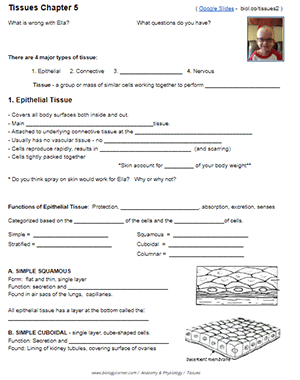
I revised the tissues unit to include a phenomenon based theme where students examine the case of a child with the epidermolysis bullosa, or butterfly skin. This lesson is part of a broader revision to my anatomy class that includes phenomenon based units for each of the body system. Unit aligns to Next Generation Science Standards (NGSS). All anatomy units can be viewed at: Biologycorner.com/Anatomy
The lesson (google slides) starts with a video showing a young girl from a documentary who has the disease. The first two minutes illustrate what life is like for Ella. Her skin must be bandaged daily because even the slightest touch can cause painful blisters.
As students progress through the slides, they fill out the guided notes and label images. Images show both epithelial and connective tissues. Students learn that the disease is caused by a mutant gene that controls the production of collagen. When this collagen is not produced, the dermis and epidermis are not held together.
Students not only learn about the layers of the skin, but how the underlying connective tissue holds the tissues together. They discover what happens when there is something wrong with those connections. The skin will peel away from the underlying tissue, causing blisters.
A coloring sheet helps student learn the parts of the matrix of connective tissue, showing how fibroblasts make collagen and elastic fibers.
The lesson ends with an exploration of skin color and evolution, with a worksheet that goes with the HHMI video on the evolution of skin color.
Research on Epidermolysis Bullosa
In addition to the lecture slides, students read about research into gene therapy and how that therapy targets the fibroblast cells that make collagen. There is great opportunity for discussion about the ethics of experimental treatment and what it is like to live with an incurable (currently) genetic disorder.


